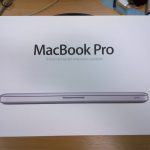
Nothing has changed much in terms of how the notebook is packed. It’s about the same as how my existing MacBook was boxed when I bought it 2 years ago. There’s a feeling of Deja Vu as I open up the compact white box and lift up the MacBook Pro.
The first time boot up of a Mac OS X machine remains familiar too. After selecting the appropriate language, a “welcome” video is played. I remember being quite entertained by the video the first time I booted up my Leopard MacBook 2 years ago. But it’s the same video I’ve seen a couple of times by now, and I don’t need to view it again. I wanted to skip it, then I found out that I can’t. We’re required to sit through the video. It’s entertaining the first time, but by now I just want to skip it. Fortunately, it doesn’t last too long.
I’ve touched and used other current generation MacBook Pros, so the aluminum unibody design is not unfamiliar to me. It has a really good feel to it, because the body is firm and sturdy, with hardly any flex when you handle it. It’s also pretty light (quite noticeably so compared to my previous MacBook) and slightly thiner. All these add together to make the new 13″ MacBook Pro easier and more comfortable to carry around and handle. Personally, the handling of the aluminum unibody is one of the best things about the new MacBook Pros. (For those unfamiliar with the unibody design: Basically the shell of the notebook is carved out of a single block of aluminum. There is no bending of metal or joining of multiple metal pieces. This makes the body of the notebook very rigid and strong.)
The 13″ LED-backlit screen is brilliant. It’s covered by a glossy surface that runs to the edge of the screen and looks really nice. Personally, I prefer not to have a glossy surface, but we don’t have much of a choice. The LED backlight means that the screen is “instant-on” (I’ve never found any of my previous CCFL screens any less instant in turning on…), lasts longer, and consumes less power. All terrific reasons to switch to LED, even if you don’t care for the environmental concerns over CCFL. The screen brightness adjusts according to the ambient light, as does the backlit keys of the keyboard.
The multitouch trackpad on this MacBook Pro is another new thing for me. The closest I have had with multitouch until now is the Apple Magic Mouse. It took some getting used to, because on the Magic Mouse needs one finger less than the multitouch trackpad for the same task. E.g. Magic Mouse scrolls with one finger, but it’s two finger on the touchpad; Magic Mouse swipes with two fingers, but it’s three fingers on the touchpad. Of course, the reason is simple: You use a single finger to move the mouse pointer on the trackpad, but with a real mouse, you move the entire mouse itself, hence you always need one finger less.
Other things I’ve noted: The sound from the MacBook Pro’s speaker is heaps better than that from my old MacBook. It’s a whole lot fuller and richer. The inclusion of a SD card reader is very convenient. There’s a single audio jack that can be used for both line-in and line-out. Cool. Sometimes I wonder, what if you want both in and out at the same time? I don’t suppose you could plug-in a split-adapter.
This new MacBook Pro has a 2.26GHz CPU, versus the 2.4GHz of my previous MacBook. The L2 cache is the same, so that means I’m upgrading to a slower CPU. But the new MacBook Pro has 1066MHz front-side bus, versus 800MHz of the old one. Coupled with faster 1066MHz RAM, hopefully that does make the new MacBook Pro faster.
The battery is rated to provide 7 hours wireless productivity. I haven’t yet had the opportunity to test this properly. 7 hours is a long time to run a test. But from what I observe so far, I imagine the new MacBook Pro should be able to run longer on its batteries than my existing MacBook does.
